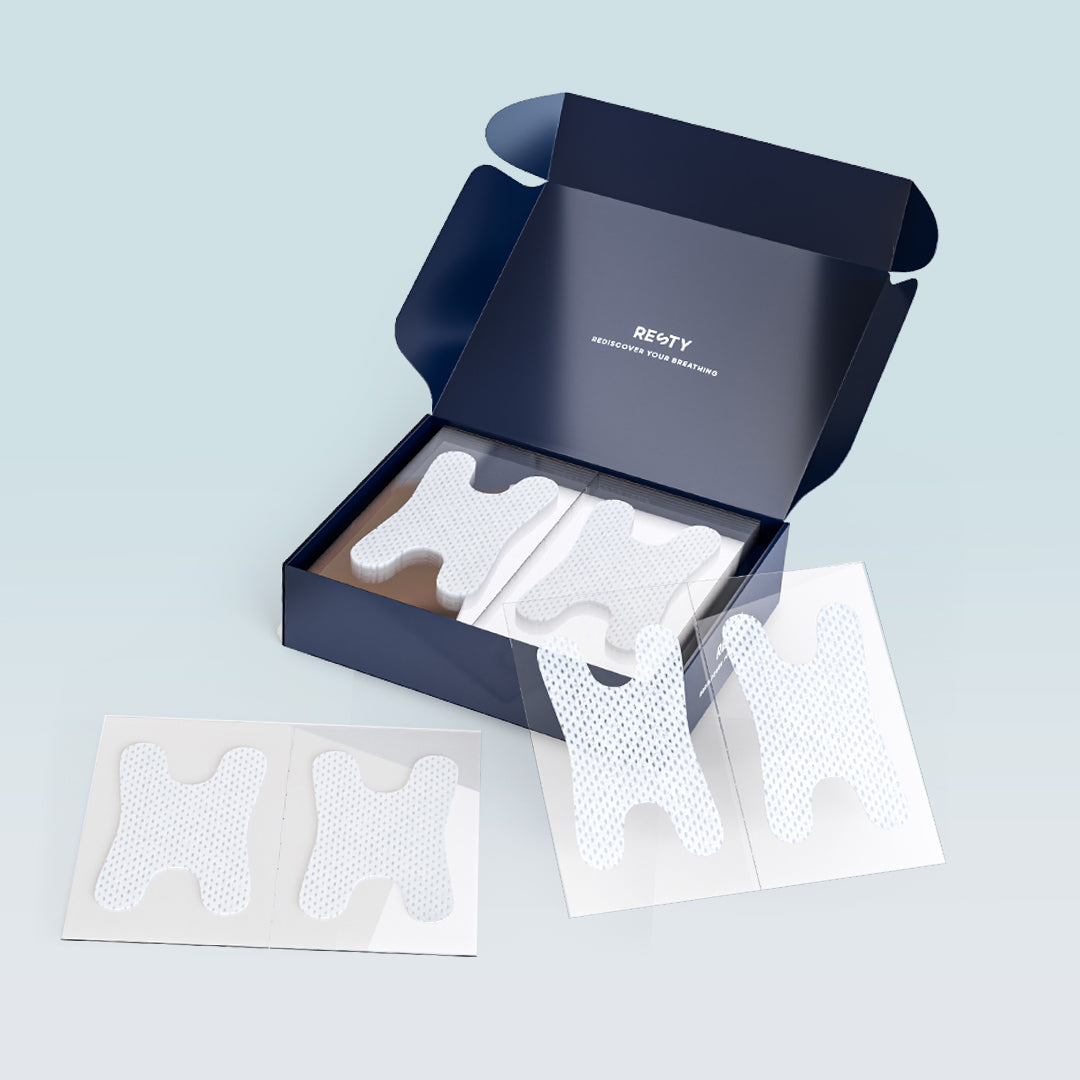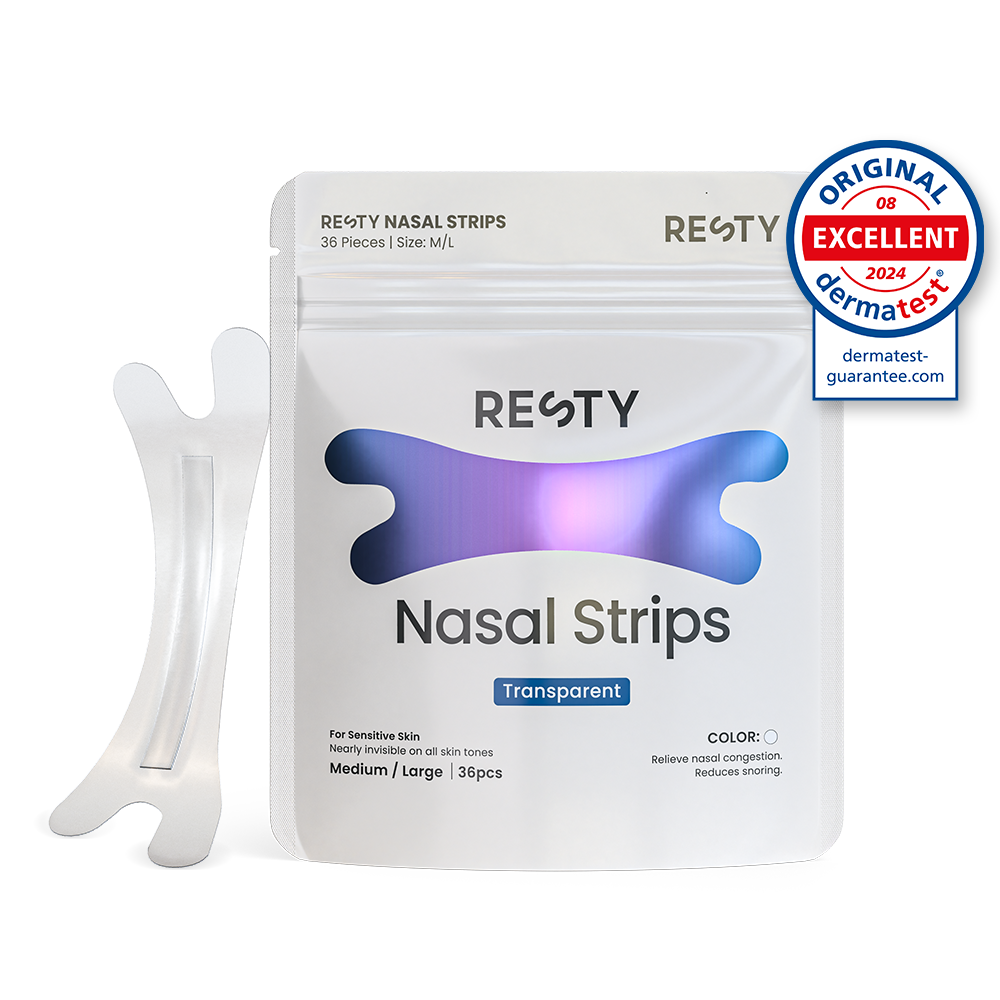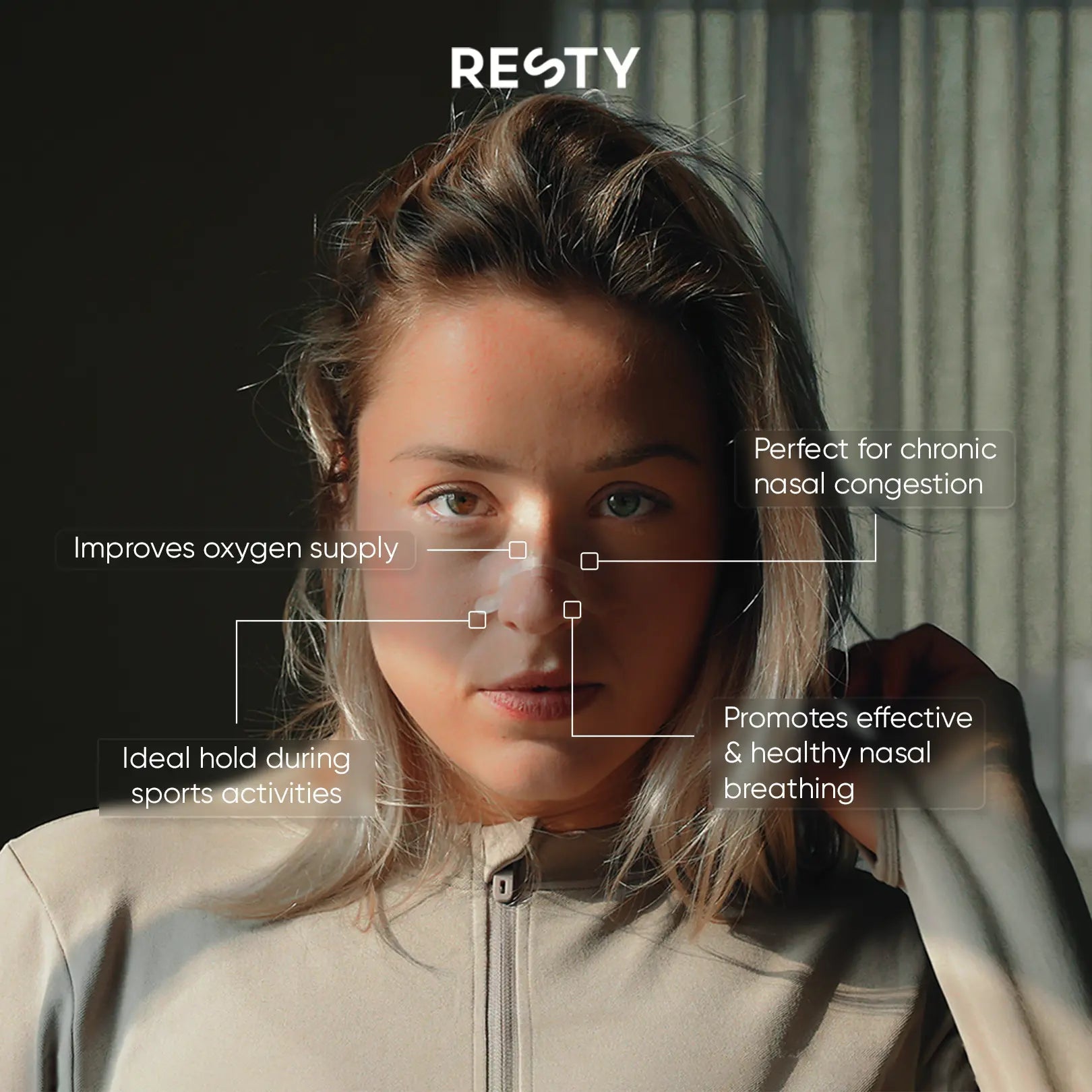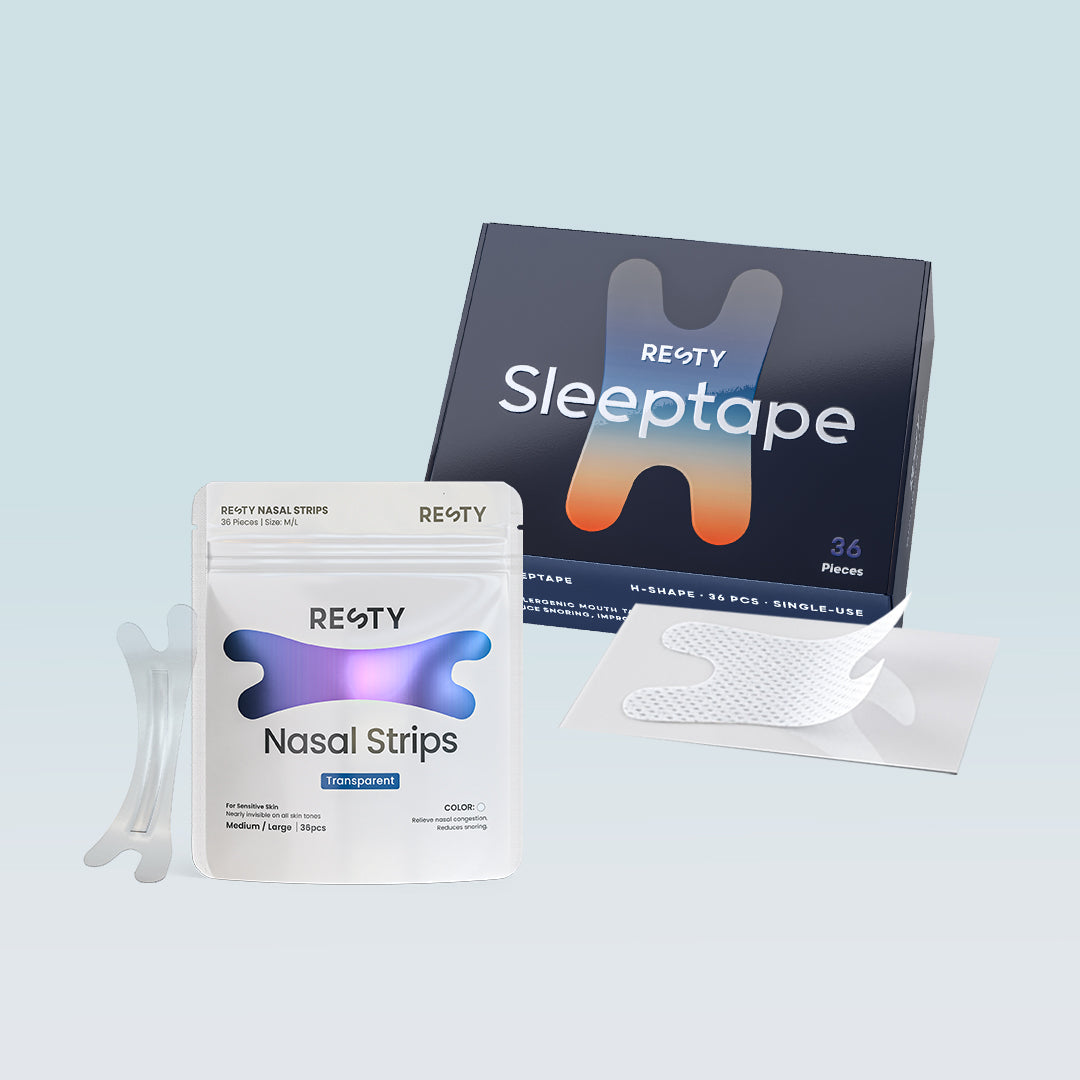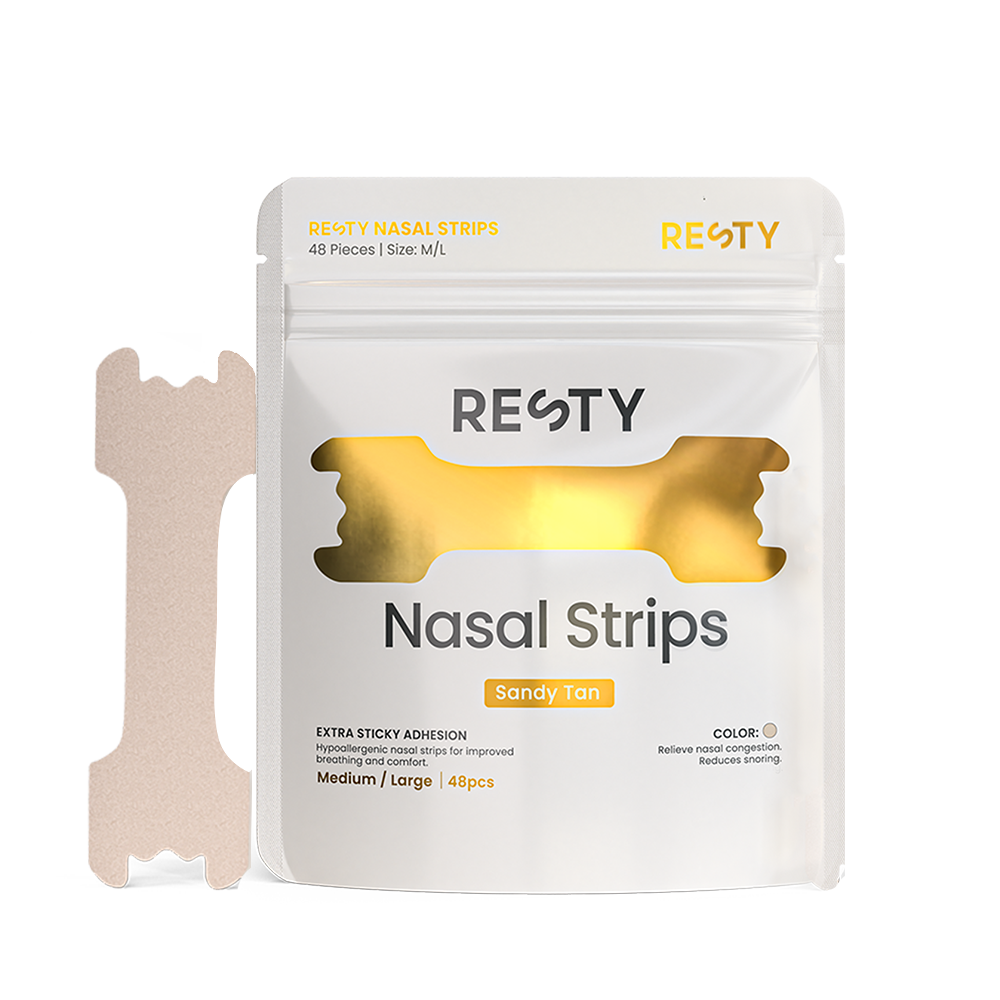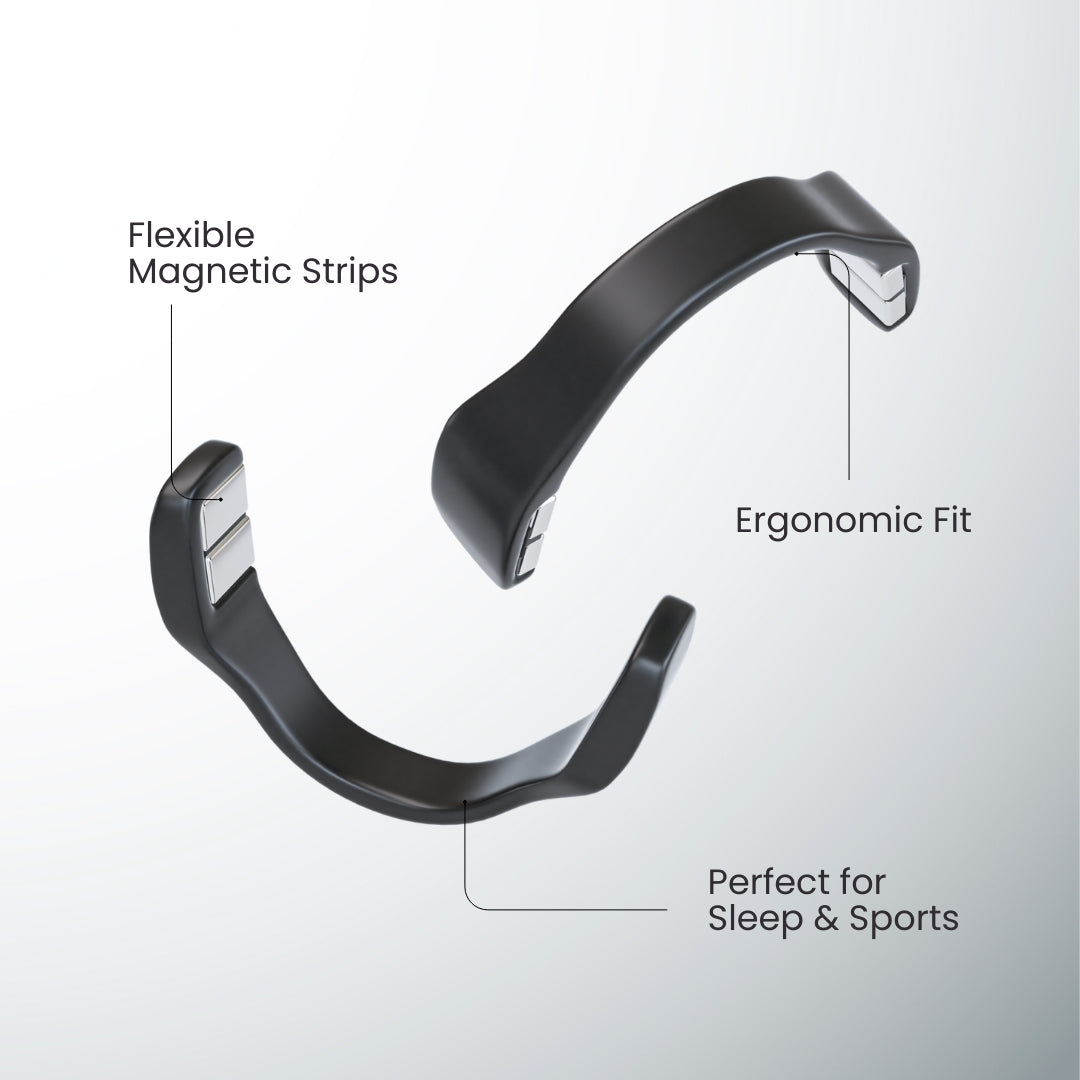Science
Nose breathing 101—Rediscover Breathing Today
Nose breathing is the most natural and beneficial way of breathing. On this page, we’ll explain the science behind nasal breathing, and most importantly, how you can start enjoying the advantages right away with the practice of mouth taping. It’s time to rediscover breathing with Resty!
Nose breathing, the natural way of breathing
The act of breathing is so simple and unconscious, we hardly give it any thought. However, a lot of us have lost the art of natural breathing through our noses. According to estimates, 30% of people don’t breathe in the way that sustains optimal health.
For nearly all animals with lungs, nose breathing—or nasal breathing—is the optimal way of breathing. You can easily observe this in babies and healthy animals. And any farmer will see mouth breathing in cattle as a sign to call the vet.
Interestingly, some animals, such as horses, are called “obligatory nose breathers”, meaning they don’t even have the physiological capability of breathing through their mouths.
In essence, our bodies are perfectly designed for nose breathing. Given the amount of space the nasal cavities occupy inside the skull, it becomes clear that our noses must be of incredible importance. “The role of the nose in health and in respiration has been greatly neglected by physicians (Timmons & Ley, 1994).”
For thousands of years indigenous humans worldwide have been aware of the benefits of nasal breathing. Breathing is a powerful type of medicine for them, and in some cases mouth breathing is even regarded as impolite.
The Indian Ayurvedic tradition, which features a well-known nostril breathing technique is a fantastic example. Or the Mexican Tarahamura Tribe, who are renowned for their remarkable long-distance running capabilities. Additionally, in many cultures, when mothers notice their infants breathing through their mouths, it’s common practice to gently close their mouths to encourage nose breathing.
As with many seemingly enigmatic practices of indigenous cultures, science eventually unearths a clear rationale behind them. The same holds true for nose breathing. If anything, our collective experience over the past few years has forced our attention back to our breathing and our respiratory system. If ever there was a time to pay close attention to your breathing and how it affects your life, it’s now.
Why is mouth breathing bad?
Before we discuss the advantages of nose breathing and how it will improve your life. Let’s first explore why mouth breathing is so harmful and how it can affect both children and adults’ health in a variety of ways.
Why mouth breathing is not natural
When breathing through the mouth, the air enters the lungs unfiltered, unheated, and unmoisturized. All of which can have detrimental effects on the health of the lungs and sinuses, leading to different various infections and illnesses. When we breathe through our mouths, we bypass all the functions the nose is designed to fulfil naturally.
Mouth breathing and dental health
Long-term mouth breathing dries out the saliva, which is the mouth’s natural cleansing mechanism to clear the mouth of harmful bacteria. This is a concern because, in addition to giving you a cottonmouth and bad breath, it can eventually lead to gum disease and tooth damage.
Mouth breathing in children
Children who frequently mouth breathe, run the risk of developing a dysfunctional jaw joint and narrowing of the jaw, dental arch, and palate, which can result in crooked teeth or an open bite (malocclusion). If severe enough, future orthodontic corrections might relapse. Additionally, mouth breathing greatly affects cognitive ability and health, as mouth breathing children perform less well in school than those who breathe naturally.
Relationship between asthma and mouth breathing
Mouth breathing could aggravate asthma, especially exercised-induced asthma. On the contrary, a study showed that when young asthma sufferers breathed through their noses, they had virtually no exercise-induced asthma symptoms.
Mouth breathing during sleep
When we sleep, mouth breathing can have the most detrimental effect. When you breathe through your mouth, your nervous system remains more active, and we retain higher levels of adrenaline, preventing you from entering into a deep sleep state and thus fully recovering for the next day. Besides that, mouth breathing can result in snoring or worse sleep disorders like sleep apnea—involuntary pauses in breathing during sleep.
Prolonged sleep deprivation impairs not only the immune system, but proper oxygenation of the blood, and cardiovascular health. Besides that, it increases the risk of diabetes, weight gain, and a low sex drive.
The mouth breather and mental health
Overall, mood and stress levels are highly influenced by the breath. When we breathe through our mouths, we tend to breathe faster and shallower which can cause a stress reaction and eventually lead to chronic hyperventilation, overbreathing, anxiety, or even depression. It’s crucial to keep in mind that this is reciprocal; tension or anxiety can also lead to (more) mouth breathing, which in turns leads to more anxiety, starting a vicious cycle.
“It appears that the connection between breathing and emotions is a reciprocative relationship, in which changes to one leads to corresponding changes in the other.” (Ley, 1994).
Mouth breathing can have an adverse effect on your mental health in ways you would not have imagined before reading this. This is in addition to a negative effect on physical health, breathlessness, and sleep disorders.
With a deliberate effort to begin nasal breathing, all of these can be prevented and reversed. Lastly, we may agree that mouth breathing isn’t very attractive.
Return to natural breathing
We’d like to clarify that healthy nose breathing may be inhibited by a blocked nose caused by (chronic) nasal congestion, enlarged tonsils, enlarged adenoids, deviated septum, nasal polyps, enlarged turbinates, tumors (rare), or deformation of the nose and jaw. We suggest that you seek a diagnosis from a doctor if you believe this might be the case for you.
Benefits of nose breathing
Mouth breathing evidently has a number of drawbacks. The practice of conscious nose breathing, on the other hand, opens up to a wide range of benefits that will significantly improve your health, performance, and overall quality of life.
The air is warmed and moisturized when inhaled through the nose, making it more pleasant for the lungs to absorb. In addition, the air is filtered by the mucous membranes after initially passing through the nasal hairs. All of these can help to increase the health of the lungs and significantly reduce the discomfort of nasal congestion, colds, and allergic reactions.
When breathing through the nose, the diaphragm is used optimally, resulting in slower airflow and slower breathing overall, which prevents overbreathing and hyperventilation. When breathing through the nose, the diaphragm is used optimally, resulting in slower airflow and slower breathing overall, which prevents overbreathing and hyperventilation.
Nasal breathing, which allows the tongue to be in the appropriate position (against the upper palate), helps prevent different facial alterations that might result from mouth breathing, as was already described.
Nose breathing during sleep
Particularly as we sleep, nose breathing can prevent snoring and, in more severe situations, sleep apnea. Overall, when we breathe naturally while we sleep, the quality of our sleep noticeably improves, which has a substantial impact on the quality of our waking life. This eventually results in a longer, healthier, and more rewarding existence.
Imagine having the energy to perform at your best every morning when you get up! You’ll notice an improvement in your focus, mood, and overall performance in daily activities when you get a good night’s sleep.
Nose breathing during exercise
Similarly, you’ll start to see an improvement in endurance when you continuously practice nose breathing while exercising, whether it’s running, yoga, or soccer. When you notice an increase in endurance, physical exercise becomes a more pleasant experience regardless of the level you are performing at. Even if you initially believed that exercising wasn’t for you, you might discover that mouth breathing was keeping you from appreciating it.
Nose breathing during cognitive activity
Studies have shown nasal breathing enhances brain activity and neural connections, making it a no-brainer whether to use the mouth or nose to breathe when you are working, managing your business or entering into a creative flow.
The science behind the benefits of nose breathing
It’s abundantly obvious that the benefits of nose breathing far outweigh the damage that mouth breathing can cause. Yet you might wonder, how does it work exactly? Below, we’ll provide a straightforward explanation of the science behind nose breathing so that everyone may fully understand, share the knowledge, and empower others!
Oxygenation of the body
Let’s first talk about breathing’s main objective, which is to supply the body with oxygen (O2).When we inhale, the air enters through the (bronchial) tubes into the lungs, which end in tiny sacs called alveoli. There the oxygen attaches to red blood cells—cells are specifically designed to attach to the oxygen (and carbon dioxide) and transport it throughout the entire body.
Every cell in the body needs oxygen to produce energy for a wide range of purposes. And just as a fire doesn’t burn without oxygen, cells can’t generate energy without it. Without energy they die, and when enough cells die, ultimately we—a vast accumulation of cells— also die.
The truth about carbondioxide (CO2)
Similar to when you burn wood, when your cells produce energy, oxygen is converted to carbon dioxide. Besides transferring oxygen into the body, our lungs also transfer carbon dioxide out of the body. However, contrary to what many people believe, carbon dioxide is more than just a waste product. It’s plays a crucial role in the oxygenation of the body.
Healthy people have blood oxygen levels that are consistently between 95 and 99 percent, whether they are at rest or engaged in physical activity, meaning there is no shortage of oxygen at any given time. The presence of carbon dioxide in the blood is necessary to cause the oxygen to detach from the red blood cells and reach all the cells in the body. Conversely, lower levels of CO2, mean the red blood cells hold on to the oxygen, and less of it reaches the cells. This is called the Bohr Effect.
In short, lower levels or CO2, means less oxygenation.
As was already established, when oxygen is released into the cells, it converts to CO2, which raises the level of CO2 in the blood. The increase in CO2 is registered by special receptors in the brain which subsequently send a signal to the breathing muscles to inhale. All this happens unconsciously.
Unlike many other bodily functions that are controlled subconsciously, we can take full control over our breathing. When we decide to hold our breath for a prolonged period of time, the CO2 levels in our blood keep rising, causing a phenomenon called air hunger; we can feel it, as our muscles contract, our throat tightens up, and our diaphragm spasms—our body urges us to breathe. Ultimately, we inhale, and exhale the built-up CO2.
Overbreathing
An optimal breathing frequency at rest is about 8-12 breaths per minute. We disturb the balance between oxygen and carbon dioxide when we breathe more frequently or excessively—called overbreathing. We release far too much CO2, and as we’ve already demonstrated, low levels of CO2 indicate poor oxygenation.
The oxygenation of the cells can be increased by intentionally breathing through the nose, which naturally causes us to breathe more slowly. Ultimately, resulting in healthier cells.. Over time, we can increase our tolerance to carbon dioxide and are able to maximize the oxygen uptake in our body. This means we can think more clearly, perform better, reduce stress, and overall increase the quality of our life.
Clear signs of overbreathing
- Mundatmung
- Atmung des oberen Brustkorbs
- Viel Seufzen
- Auffällige Atmung in Ruhe
- Vor dem Sprechen ausgiebig inhalieren
Another truth revealed - nitric oxide and nasal breathing
Besides carbon dioxide and oxygen, there is another important player in the breathing cycle—nitric oxide. This chemical aids the body’s process of widening blood arteries to improve blood flow. It has been shown to improve athletic performance as well as lowering blood pressure, risk of infection and inflammation, heart disease, and strokes.
Additionally, nitric oxide has antiviral and antibacterial properties and could help prevent respiratory infections and illness linked to viruses and bacteria, such as Covid.
Previously considered purely poisonous, nitric oxide is produced in small quantities in the nose and sinuses and transferred into the rest of the body upon inhalation. When breathing through our mouth, we bypass the benefits of nitric oxide.
How to promote nose breathing
For someone that has been mouth breathing their whole lives, it might seem challenging to develop the healthy habit of nose breathing. But it’s not impossible. There are various practices that can decrease and eventually eliminate mouth breathing from you life.
- Familiarize yourself with the benefits of nose breathing (you are already on your way)
- Become mindful of your breath (were you nose breathing while reading this page?)
- Avoid or decrease nasal congestion if you have it
- Do breathing exercises
- Meditate
- Start mouth taping during sleep, exercise, or meditation.
The practice of mouth taping
Mouth taping is a simple, yet effective way to promote nose breathing during sleep or exercise. Resty has created mouth tape especially designed to safely mouth tape during sleep. It’s made from breathable, hypoallergenic tape to avoid skin irritations or reaction. It’s not too sticky to cause any damage, but sticky enough to keep the lips closed.
When mouth taping, the goal is not to keep the lips forcefully shut. Rather, it’s to evoke a neurological reminder to keep breathing through the nose. If the mouth needs to be opened at any point, it can be easily done.
Besides that, Resty Sleep Tape is non-invasive and non-addictive, and therefore completely safe to use
Start Nose Breathing Today!
Rediscover breathing by returning to natural breathing through the nose. Over time, you will reap all the benefits of nasal breathing and will witness an increase in your health, performance, and overall quality of life. Start nose breathing today with Resty’s Sleep Tape for mouth.
Mouth taping is non-addictive, and three months is usually enough to restore the habit of nose breathing during sleep.
Sources
Ahmad, A., Dempsey, S. K., Daneva, Z., Azam, M., Li, N., Li, P. L., & Ritter, J. K. (2018). Role of Nitric Oxide in the Cardiovascular and Renal Systems. International journal of molecular sciences, 19(9), 2605.
Chen, Z. Q., Mou, R. T., Feng, D. X., Wang, Z., & Chen, G. (2017). The role of nitric oxide in stroke. Medical gas research, 7(3), 194–203.
Hallani, M., Wheatley, J.R., Amis, T.C. (2005). Enforced mouth breathing decreases lung function in mild asthamatic. Respirology, 13, 553-558
Harvold, E. P., Tomer, B. S., Vargervik, K., & Chierici, G. (1981). Primate experiments on oral respiration. American journal of orthodontics, 79(4), 359–372.
Jung, J. Y., & Kang, C. K. (2021). Investigation on the Effect of Oral Breathing on Cognitive Activity Using Functional Brain Imaging. Healthcare, 9(6), p. 645.
Kimberly, B., Nejadnik, B., Giraud, G. D., & Holden, W. E. (1996). Nasal contribution to exhaled nitric oxide at rest and during breathholding in humans. American journal of respiratory and critical care medicine, 153(2), 829–836. .
Kobayashi, M., Fukuda, S., Takano, K., Kamizono, J., Ichikawa, K. (2018) Can a pulse oxygen saturation of 95% to 96% help predict further vital sign destabilization in school-aged children? Medicine, 97(25), 11135.
Kuroishi, R. C., Garcia, R. B., Valera, F. C., Anselmo-Lima, W. T., & Fukuda, M. T. (2015). Deficits in working memory, reading comprehension and arithmetic skills in children with mouth breathing syndrome: analytical cross-sectional study.Sao Paulo medical journal = Revista paulista de medicina, 133(2), 78–83.
Ley, R. (1994). Breathing and the psychology of emotion, cognition, and behavior. In B. H. Timmons & R. Ley (Eds.),Behavioral and psychological approaches to breathing disorders (pp. 81–95). Plenum Press.
Mangla, P. K., & Menon, M. P. (1981). Effect of nasal and oral breathing on exercise-induced asthma. Clinical allergy, 11(5), 433–439.
Naseem K. M. (2005). The role of nitric oxide in cardiovascular diseases. Molecular aspects of medicine, 26(1-2), 33–65.
Ohki, M., Usui, N., Kanazawa, H., Hara, I., & Kawano, K. (1996). Relationship between oral breathing and nasal obstruction in patients with obstructive sleep apnea. Acta oto-laryngologica. Supplementum, 523, 228–230.
Olsson, A. (2014). Conscious Breathing. Conscious Breathing. Discover the Power of Your Breath. Sorena AB.
Martel, J., Ko, Y. F., Young, J. D., & Ojcius, D. M. (2020). Could nasal nitric oxide help to mitigate the severity of COVID-19?. Microbes and infection, 22(4-5), 168–171. https://doi.org/10.1016/j.micinf.2020.05.002
McKeown, P. (2015). The Oxygen Advantage. Little, Brown Book Group.
Ruth, Allen. (2015). The health benefits of nose breathing. Nursing in General Practice.
Selim, B., Won, C. (2010). Cardiovascular Consequences of Sleep Apnea. Clinics in Chest Medicine, 31(2), 203-220.
Tripathi, P., Tripathi, P., Kashyap, L., Singh, V. (2007) The role of nitric oxide in inflammatory reactions. FEMS Immunology & Medical Microbiology, 51(3), 443–452.
Disclaimer
The content on this website and the other Resty channels is for informational and educational purposes only, and does not substitute professional medical advice or consultation with healthcare professionals. If you are seeking medical advice, diagnosis, or treatment, we advise you to consult a medical professional or healthcare provider.
Reclaim your rest




